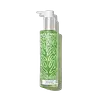What's inside
What's inside
 Key Ingredients
Key Ingredients

 Benefits
Benefits

 Concerns
Concerns

 Ingredients Side-by-side
Ingredients Side-by-side

Water
Skin ConditioningGlycerin
HumectantCocamidopropyl Hydroxysultaine
CleansingSodium Cocoyl Isethionate
CleansingSodium Methyl Cocoyl Taurate
CleansingSodium Hydrolyzed Potato Starch Dodecenylsuccinate
Hydrolyzed Hyaluronic Acid
HumectantEthylhexylglycerin
Skin ConditioningLinoleamidopropyl Pg-Dimonium Chloride Phosphate
Polyquaternium-10
Polysorbate 20
EmulsifyingSodium Isethionate
CleansingSodium Lauryl Sulfate
CleansingSodium C14-16 Olefin Sulfonate
CleansingPotassium Acrylates Copolymer
Sodium Chloride
MaskingPropylene Glycol
HumectantDisodium EDTA
Citric Acid
BufferingSodium Hydroxide
BufferingHydroxyacetophenone
AntioxidantTocopheryl Acetate
AntioxidantPhenoxyethanol
PreservativeParfum
MaskingWater, Glycerin, Cocamidopropyl Hydroxysultaine, Sodium Cocoyl Isethionate, Sodium Methyl Cocoyl Taurate, Sodium Hydrolyzed Potato Starch Dodecenylsuccinate, Hydrolyzed Hyaluronic Acid, Ethylhexylglycerin, Linoleamidopropyl Pg-Dimonium Chloride Phosphate, Polyquaternium-10, Polysorbate 20, Sodium Isethionate, Sodium Lauryl Sulfate, Sodium C14-16 Olefin Sulfonate, Potassium Acrylates Copolymer, Sodium Chloride, Propylene Glycol, Disodium EDTA, Citric Acid, Sodium Hydroxide, Hydroxyacetophenone, Tocopheryl Acetate, Phenoxyethanol, Parfum
Water
Skin ConditioningGlycerin
HumectantCocamidopropyl Hydroxysultaine
CleansingSodium Laurylglucosides Hydroxypropylsulfonate
CleansingPolyglyceryl-6 Caprylate
EmulsifyingSclerotium Gum
Emulsion StabilisingSorbitan Oleate Decylglucoside Crosspolymer
CleansingSodium Chloride
MaskingSodium Levulinate
Skin ConditioningCarrageenan
Ananas Sativus Fruit Extract
Skin ConditioningSodium Anisate
AntimicrobialCitric Acid
BufferingMelia Azadirachta Leaf Extract
Skin ConditioningCamellia Sinensis Leaf Extract
AntimicrobialCitrus Aurantium Bergamia Fruit Extract
Skin ConditioningCitrus Limon Peel Extract
EmollientCucumis Sativus Fruit Extract
EmollientLavandula Angustifolia Flower/Leaf/Stem Extract
MaskingTriethyl Citrate
MaskingLactobacillus Ferment
Skin ConditioningMelia Azadirachta Flower Extract
Skin ConditioningPyrus Malus Fruit Extract
Skin ConditioningRosmarinus Officinalis Leaf Extract
AntimicrobialRubus Idaeus Fruit Extract
AstringentSalvia Officinalis Leaf Extract
CleansingSalvia Sclarea Extract
AntiseborrhoeicVaccinium Macrocarpon Fruit Extract
AstringentVanilla Planifolia Fruit Extract
Skin ConditioningTetrasodium Glutamate Diacetate
Aloe Barbadensis Leaf Juice
Skin ConditioningLimonene
PerfumingLinalool
PerfumingWater, Glycerin, Cocamidopropyl Hydroxysultaine, Sodium Laurylglucosides Hydroxypropylsulfonate, Polyglyceryl-6 Caprylate, Sclerotium Gum, Sorbitan Oleate Decylglucoside Crosspolymer, Sodium Chloride, Sodium Levulinate, Carrageenan, Ananas Sativus Fruit Extract, Sodium Anisate, Citric Acid, Melia Azadirachta Leaf Extract, Camellia Sinensis Leaf Extract, Citrus Aurantium Bergamia Fruit Extract, Citrus Limon Peel Extract, Cucumis Sativus Fruit Extract, Lavandula Angustifolia Flower/Leaf/Stem Extract, Triethyl Citrate, Lactobacillus Ferment, Melia Azadirachta Flower Extract, Pyrus Malus Fruit Extract, Rosmarinus Officinalis Leaf Extract, Rubus Idaeus Fruit Extract, Salvia Officinalis Leaf Extract, Salvia Sclarea Extract, Vaccinium Macrocarpon Fruit Extract, Vanilla Planifolia Fruit Extract, Tetrasodium Glutamate Diacetate, Aloe Barbadensis Leaf Juice, Limonene, Linalool
 Reviews
Reviews

Ingredients Explained
These ingredients are found in both products.
Ingredients higher up in an ingredient list are typically present in a larger amount.
Citric Acid is an alpha hydroxy acid (AHA) naturally found in citrus fruits like oranges, lemons, and limes.
Like other AHAs, citric acid can exfoliate skin by breaking down the bonds that hold dead skin cells together. This helps reveal smoother and brighter skin underneath.
However, this exfoliating effect only happens at high concentrations (20%) which can be hard to find in cosmetic products.
Due to this, citric acid is usually included in small amounts as a pH adjuster. This helps keep products slightly more acidic and compatible with skin's natural pH.
In skincare formulas, citric acid can:
While it can provide some skin benefits, research shows lactic acid and glycolic acid are generally more effective and less irritating exfoliants.
Most citric acid used in skincare today is made by fermenting sugars (usually from molasses). This synthetic version is identical to the natural citrus form but easier to stabilize and use in formulations.
Read more about some other popular AHA's here:
Learn more about Citric AcidCocamidopropyl Hydroxysultaine is a synthetic cleansing agent, though it is derived from coconut oil.
It is used to enhance the texture of products by boosting lather and thickening the texture. As a cleanser, Cocamidopropyl Hydroxysultaine is mild.
Glycerin is already naturally found in your skin. It helps moisturize and protect your skin.
A study from 2016 found glycerin to be more effective as a humectant than AHAs and hyaluronic acid.
As a humectant, it helps the skin stay hydrated by pulling moisture to your skin. The low molecular weight of glycerin allows it to pull moisture into the deeper layers of your skin.
Hydrated skin improves your skin barrier; Your skin barrier helps protect against irritants and bacteria.
Glycerin has also been found to have antimicrobial and antiviral properties. Due to these properties, glycerin is often used in wound and burn treatments.
In cosmetics, glycerin is usually derived from plants such as soybean or palm. However, it can also be sourced from animals, such as tallow or animal fat.
This ingredient is organic, colorless, odorless, and non-toxic.
Glycerin is the name for this ingredient in American English. British English uses Glycerol/Glycerine.
Learn more about GlycerinChances are, you eat sodium chloride every day. Sodium Chloride is also known as table salt.
This ingredient has many purposes in skincare: thickener, emulsifier, and exfoliator.
You'll most likely find this ingredient in cleansers where it is used to create a gel-like texture. As an emulsifier, it also prevents ingredients from separating.
There is much debate on whether this ingredient is comedogenic. The short answer - comedogenic ratings don't tell the whole story. Learn more about comegodenic ratings here.
The concensus about this ingredient causing acne seems to be divided. Research is needed to understand if this ingredient does cause acne.
Scrubs may use salt as the primary exfoliating ingredient.
Learn more about Sodium ChlorideWater. It's the most common cosmetic ingredient of all. You'll usually see it at the top of ingredient lists, meaning that it makes up the largest part of the product.
So why is it so popular? Water most often acts as a solvent - this means that it helps dissolve other ingredients into the formulation.
You'll also recognize water as that liquid we all need to stay alive. If you see this, drink a glass of water. Stay hydrated!
Learn more about Water